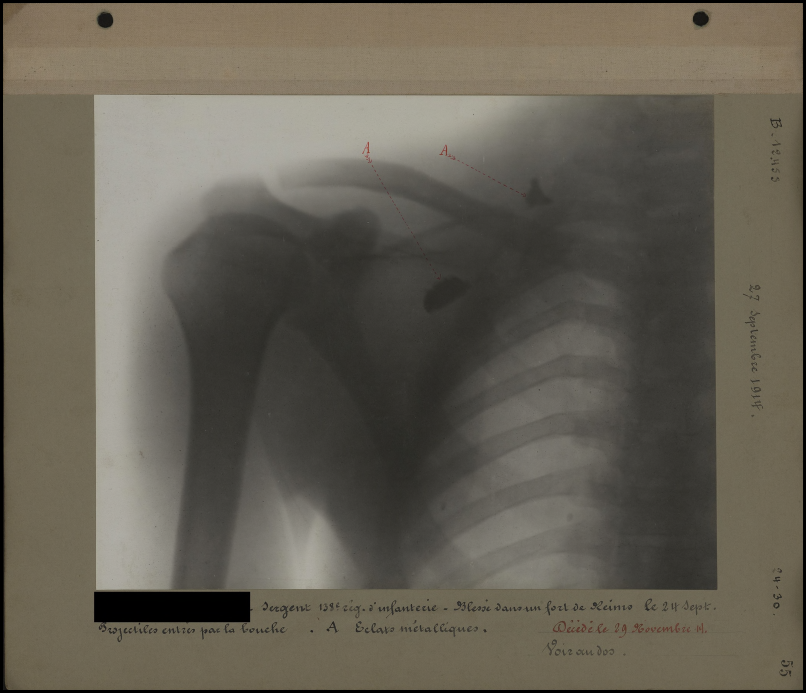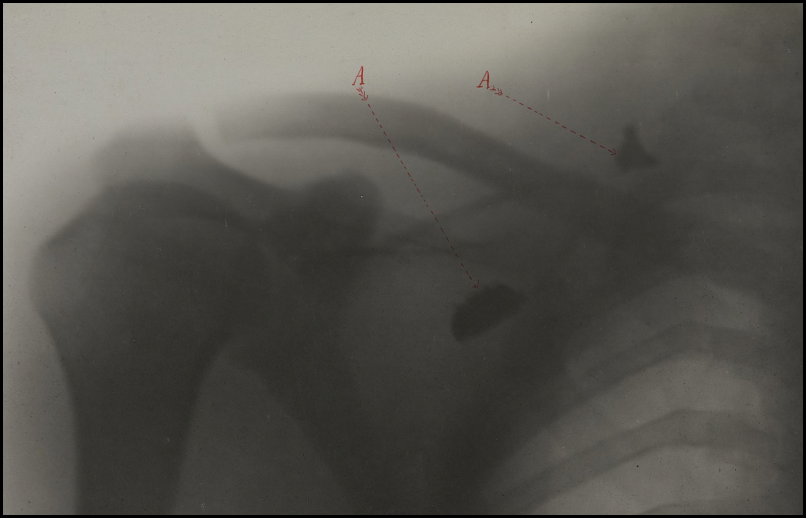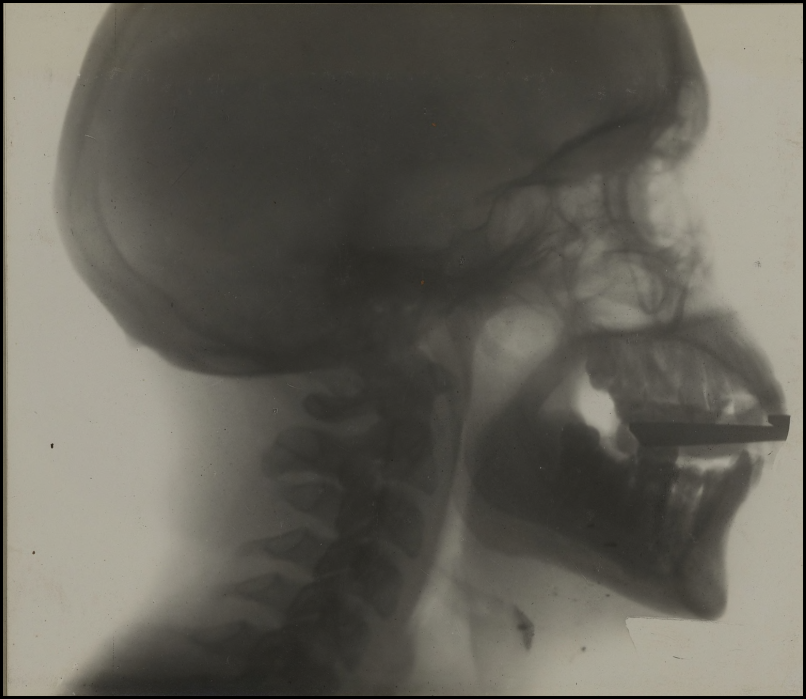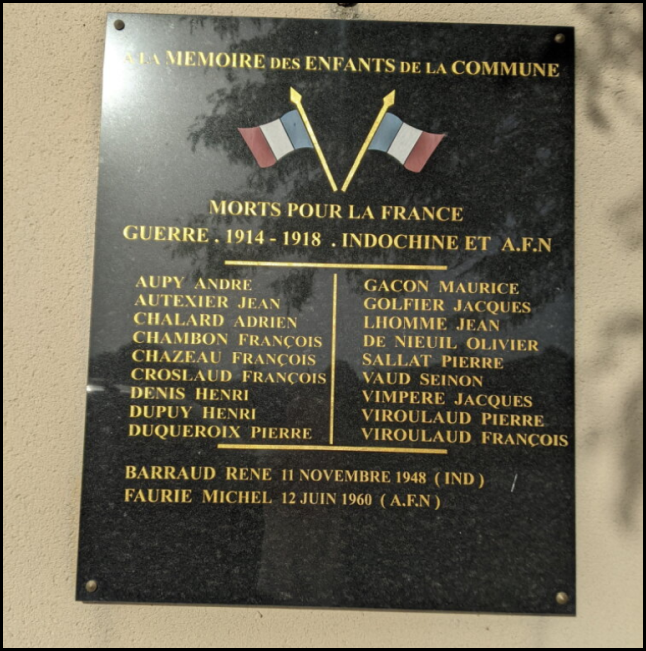Because of the delay in communicating medical information, it is necessary to wait 120 years after the patient’s death to have access to medical records. In order to allow these documents to be distributed while respecting this time limit, the documents provided by the Salpêtrière hospital have been anonymised. In two albums, they show X-rays of soldiers wounded at the start of the conflict.
Finding the names of the wounded x-rayed and discovering their fate is therefore only possible if the captions provide significant information: a date of injury and a precise rank in addition to the unit. A unit alone for an ordinary soldier makes the mission virtually impossible. One simple exception: the unit and date of death of a sergeant of the 138th RI made it possible to trace the career of one of these wounded soldiers.

- L’indexation de MDH
Thanks to the indexing work carried out 10 years ago, finding this man was very simple: in Mémoire des Hommes (MDH), searching by date and by unit produced two names and… two sergeants. However, there was one factor that argued in favour of one more than the other: Sergeant Jérémie Mouteau died at the age of 30 in a medical facility in Vichy, while Sergeant André Aupy died at the Salpêtrière hospital. However, the photographs were taken at La Salpêtrière and the deceased soldier was only 20 years old.
- The life of André Aupy
A student in October 1912, André Aupy was just over 18 years old when he signed up for a three-year voluntary service known as ‘anticipation of call-up’. This type of enlistment tells us that he held a Military Aptitude Certificate.
(…) Tous les ans, mais seulement dans une proportion qui ne pourra dépasser quatre pour cent (4 p. 100) de l’effectif de la dernière classe incorporée, les jeunes gens âgés d’au moins dix-huit ans, remplissant les conditions d’aptitude physique ainsi que les autres conditions énumérées au présent article, et pourvus du certificat d’aptitude militaire institué par la loi du 8 avril 1903, seront admis par ordre de mérite à contracter, au moment de l’incorporation de la classe, un engagement spécial de trois ans — dit de devancement d’appel — avec la faculté d’être mis en congé après deux années de service, s’ils ont :
1° – Obtenu le certificat d’aptitude aux fonctions de chef de section ;
2° – Pris l’engagement d’effectuer tous les trois ans, pendant la durée de leurs obligations militaires, des périodes de quatre semaines dans la réserve et de deux semaines dans la territoriale. (…)Extrait de la loi du 21 mars 1905 modifiant la loi du 15 juillet 1889 sur le recrutement de l’armée et réduisant à deux ans la durée du service dans l’armée active, art. 50 (J.O. 23 mars 1905, p. 1.869).
He then progressed through the various stages before being able to consider taking the section leader aptitude certificate: he became a private 1st class on 1 July 1913, a corporal on 11 November 1913 and a sergeant on mobilisation on 2 August 1914. On 24 September, the regiment took part in the fierce fighting around Fort de la Pompelle, to the east of Reims. It was there that André Aupy was wounded in precisely unknown circumstances. The nature of his injury is also unclear on the two X-rays that document it. They do tell us, however, that he was hit by shrapnel that passed through his mouth before lodging in his chest. The first was taken on 27 September 1914.

The second, taken on 7 November, shows his skull without the untrained eye noticing much.

His death certificate gives us no further information about the causes of his death on the night of 29 November 1914 at 4am.
- Conclusion
The circumstances of his injury and death remain unknown to us in detail, but these X-rays show both the progress made in medicine at the time and the damage done to bodies. Shrapnel, shrapnel shells, bullets and even shrapnel pellets caused considerable damage that was clearly visible on the bones, but was also invisible on X-rays, even though it was just as deadly, as André Aupy’s case shows. His name, still hidden for a few years on the original document, appears on the plaque of the commune of Orgedeuil.

Sources :
BIU Santé (Paris). Cote : pall_rx_01. Ensemble de radiographies destinées à localisation de corps étrangers (crâne, tronc, membres). Fonds Guy et Marie-José Pallardy
https://www.biusante.parisdescartes.fr/histoire/medica/resultats/index.php?do=chapitre&cote=pallrx01
Service Historique de la Défense :
SHD GR 26 N 690/3 : JMO du 138e RI, volume 1.
Archives départementales de Charente :
1 R 232 : fiche matricule de Aupy André Médéric, classe 1914, matricule 4 au bureau de recrutement d’Angoulême.
https://lasource.archives.lacharente.fr/ark:/61904/s00552b6053361a9.55a6802a7294e/img:FRAD016_1R_0232_0005
1 R 120 : liste matricule de Aupy André Médéric, année 1912, matricule 119.
https://lasource.archives.lacharente.fr/ark:/61904/s00552b60532bb2f.559e5cfa7a289/img:FRAD016_1R_0214_0120
Archives de Paris :
13D 197 : état-civil du 13e arrondissement, actes de décès pour l’année 1913. Acte 4767.
Archives départementales de la Haute-Vienne :
3 E 67 / 11 – état-civil de la commune de Folles, décès 1903–1915.
Archives départementales de la Creuse :
1 R 504 : fiche matricule de Mouteau Jérémie, classe 1903, matricule 243 au bureau de recrutement de Magnac-Laval.
https://archives.creuse.fr/ark:22575/s005f5e49b288de5/5f5e49b289de7.fiche=arko_fiche_60898d215195d.moteur=arko_default_60b7735bea18e
Monument aux morts d’Orgedeuil : https://www.geneanet.org/cimetieres/view/11799669
